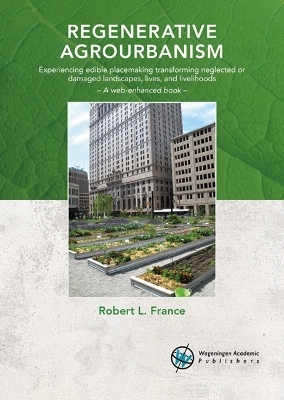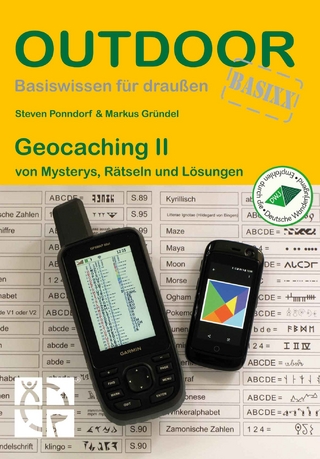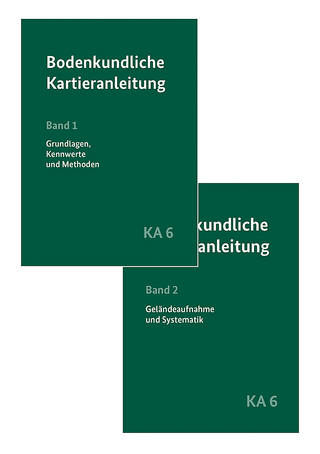
Regenerative agrourbanism
Wageningen Academic Publishers (Verlag)
978-90-8686-386-0 (ISBN)
Robert L. France is a world-renowned scientist in the Faculty of Agriculture at Dalhousie University, where he teaches courses on urban agriculture, ecohydrology, watershed management, conservation biology, and environmental restoration. For more than a decade he taught and conducted research on landscape architecture, land-use planning, and urban design at the Harvard Design School. Dr. France is the author or editor of twenty-two books and more than two hundred journal articles on a wide range of environmental subjects, which together have been cited more than ten thousand times in the professional literature. In 2010, he organized the first international academic conference on urban agriculture in Canada, which led to the publication of the edited volume Integrated Urban Agriculture: Precedents, Practices, Prospects. His previous book with Wageningen Academic Publishers is about the pre-plastic environmental history of fishery bycatch: Disentangled: Ethnozoology and Environmental Explanation of the Gloucester Sea Serpent."
Robert L. France is a world-renowned scientist in the Faculty of Agriculture at Dalhousie University, where he teaches courses on urban agriculture, ecohydrology, watershed management, conservation biology, and environmental restoration. For more than a decade he taught and conducted research on landscape architecture, land-use planning, and urban design at the Harvard Design School. Dr. France is the author or editor of twenty-two books and more than two hundred journal articles on a wide range of environmental subjects, which together have been cited more than ten thousand times in the professional literature. In 2010, he organized the first international academic conference on urban agriculture in Canada, which led to the publication of the edited volume Integrated Urban Agriculture: Precedents, Practices, Prospects. His previous book with Wageningen Academic Publishers is about the pre-plastic environmental history of fishery bycatch: Disentangled: Ethnozoology and Environmental Explanation of the Gloucester Sea Serpent.
Table of contents
Preface - Situating urban agriculture tours in time and 'splace' 13
References 16
Acknowledgements
Part 1 - Background 21
Chapter 1. Place - Plants - People: the paradigm of regenerative agrourbanism as waymarked through ten formative books 23
1.1 Agrourbanism: 'talkin' 'bout ... [re]generation' 23
1.2 Agrorestorative nucleus 25
1.2.1 Agriculture 25
1.2.2 Restoration 27
1.3 Regenerative constituents 30
1.3.1 Place 30
1.3.2 Plants 31
1.3.3 People 33
References 35
Chapter 2. Narrative scholarship and peripatetic phenomenology as landscape research 39
2.1 Sensorial embodied experience 39
2.2 Thick descriptions 40
2.3 Walking methodology 42
References 44
Part 2 - Visits 47
Chapter 3. Healing economies: business and tourism 49
3.1 Commercial enterprises 49
3.1.1 London Cru Urban Winery (London, UK) 51
3.1.2 Brother Nature Produce (Detroit, MI, USA) 53
3.1.3 Hope Blooms (Halifax, NS, Canada) 54
3.1.4 Dill's Pumpkin Farm (Windsor, NS, Canada) 56
3.1.5 Fresh City Farms (Toronto, ON, Canada) 58
3.1.6 Very Local Greens (Dartmouth, NS, Canada) 61
3.1.7 Food from the Sky (London, UK) 64
3.1.8 GrowUp Box Urban Farms (London, UK) 67
3.1.9 FARM:shop (London, UK) 70
3.1.10 Valley Grown Salads (Harlow, UK) 73
3.1.11 Zero Carbon Food (London, UK) 77
3.1.12 Lufa Farms (Montreal, PQ, Canada) 80
3.1.13 Case study lessons 86
3.2 Food market tourism 87
3.2.1 Plaza de Armas (Ancud, Isla Chiloe, Chile) 89
3.2.2 The Goods Shed (Canterbury, UK) 91
3.2.3 Kensington Market (Toronto, ON, Canada) 93
3.2.4 Haymarket (Boston, MA, USA) 95
3.2.5 Farmers' Markets (Halifax, NS, Canada) 97
3.2.6 Eastern Market (Detroit, MI, USA) 100
3.2.7 Feria Alcalde Jose Sandoval Gomez (Castro, Isla Chiloe, Chile) 102
3.2.8 St. Lawrence Market (Toronto, ON, Canada) 104
3.2.9 Mercado do Bolhao (Porto, Portugal) 107
3.2.10 El Mercadeo Central (Valencia, Spain) 109
3.2.11 Borough Market (London, UK) 112
3.2.12 Mercado de La Boqueria (Barcelona, Spain) 116
3.2.13 Markthal (Rotterdam, the Netherlands) 120
3.2.14 Case study lessons 125
References 126
Chapter 4. Healing connections: hope and education 131
4.1 Community sustaining gardens 131
4.1.1 Cultivate London (London, UK) 133
4.1.2 The Stop's Earlscourt Community Garden and Food Centre (Toronto, ON, Canada) 135
4.1.3 D-Town Farm (Detroit, MI, USA) 139
4.1.4 Regent Park Health Centre Community Garden (Toronto, ON, Canada) 142
4.1.5 Aghios Dimitrios Municipal Garden (Athens, Greece) 143
4.1.6 Brightmoor Alliance Youth Garden (Detroit, MI, USA) 146
4.1.7 Southside City Farm (Providence, RI, USA) 149
4.1.8 Kipos3 Community Garden and Urban Vineyard (Thessaloniki, Greece) 152
4.1.9 Common Roots Urban Farm (Halifax, NS, Canada) 155
4.1.10 Case study lessons 160
4.2 Educational farms 161
4.2.1 Kentish Town City Farm (London, UK) 164
4.2.2 Hackney City Farm (London, UK) 166
4.2.3 Vauxhall City Farm (London, UK) 169
4.2.4 Surrey Docks Farm (London, UK) 172
4.2.5 Mudchute Park and Farm (London, UK) 175
4.2.6 Spitalfields City Farm (London, UK) 179
4.2.6 Case study lessons 185
References 186
Chapter 5. Healing art: beautifully grown food 189
5.1 Art-filled gardens 189
5.1.1 Dalston Eastern Curve Garden (London, UK) 191
5.1.2 Fenway Victory Gardens (Boston, MA, USA) 194
5.1.3 Case study lessons 198
5.2 Artful gardens 199
5.2.1 Edible Estates (London, UK) 201
5.2.2 The Edible Bus Stop (London, UK) 203
5.2.3 Abbey Gardens (London, UK) 206
5.2.4 Carrot Green Roof and Garden (Toronto, ON, Canada) 210
5.2.5 Lafayette Greens (Detroit, MI, USA) 214
5.2.6 Case study lessons 219
References 219
Chapter 6. Healing heritage: restoring agri-culture 223
6.1 Heritage and homage 223
6.1.1 Spryfield Kidston Urban Farm (Halifax, NS, Canada) 226
6.1.2 Zorbis Office and Apartment Building (Athens, Greece) 228
6.1.3 Chiswick House Kitchen Garden (London, UK) 230
6.1.4 Riverdale Farm (Toronto, ON, Canada) 232
6.1.5 Cole Harbour Heritage Farm Museum (Halifax, NS, Canada) 234
6.1.6 Norsk Folkmuseum (Oslo, Norway) 238
6.1.7 Case study lessons 241
6.2 Civitas 242
6.2.1 Woodlands Farm Trust (London, UK) 244
6.2.2 Farm Centre's Legacy Garden (Charlottetown, PEI, Canada) 246
6.2.3 Mikveh Israel Agriculture School (Tel Aviv, Israel) 250
6.2.4 Les Hortillonnages (Amiens, France) 252
6.2.5 Yedikule Gardens (Istanbul, Turkey) 255
6.2.6 Parc Agrai de Baix Llobregat (Barcelona, Spain) 258
6.2.7 Case study lessons 263
References 263
Chapter 7. Healing sites and societies: regenerative landscape design 265
7.1 Structures and sites 265
7.1.1 60 Richmond Street Housing (Toronto, ON, Canada) 267
7.1.2 King's Cross Central Skip Garden (London, UK) 268
7.1.3 Hellinikon Airport Community Garden (Athens, Greece) 271
7.1.4 Greensgrow Farms (Philadelphia, PA, USA) 274
7.1.5 Evergreen Brick Works (Toronto, ON, Canada) 279
7.1.6 Artspace Wychwood Barns (Toronto, ON, Canada) 284
7.1.7 Allen Street Garden (Boston, MA, USA) 288
7.1.8 PERKA (Thessalonki, Greece) 290
7.1.9 Mill Creek Farm (Philadelphia, PA, USA) 292
7.1.10 Case study lessons 295
7.2 Souls and societies 296
7.2.1 Natural Growth Project (London, UK) 298
7.2.2 Forty Hall Vineyard (London, UK) 302
7.2.3 ReVision Urban Farm (Boston, MA, USA) 306
7.2.4 Earthworks Urban Farm (Detroit, MI, USA) 309
7.2.5 Detroit Dreams (Detroit, MI, USA) 313
7.2.6 Case study lessons 322
References 323
| Erscheinungsdatum | 01.11.2022 |
|---|---|
| Sprache | englisch |
| Maße | 170 x 240 mm |
| Gewicht | 1 g |
| Themenwelt | Naturwissenschaften ► Geowissenschaften ► Geografie / Kartografie |
| Weitere Fachgebiete ► Land- / Forstwirtschaft / Fischerei | |
| ISBN-10 | 90-8686-386-8 / 9086863868 |
| ISBN-13 | 978-90-8686-386-0 / 9789086863860 |
| Zustand | Neuware |
| Haben Sie eine Frage zum Produkt? |
aus dem Bereich


